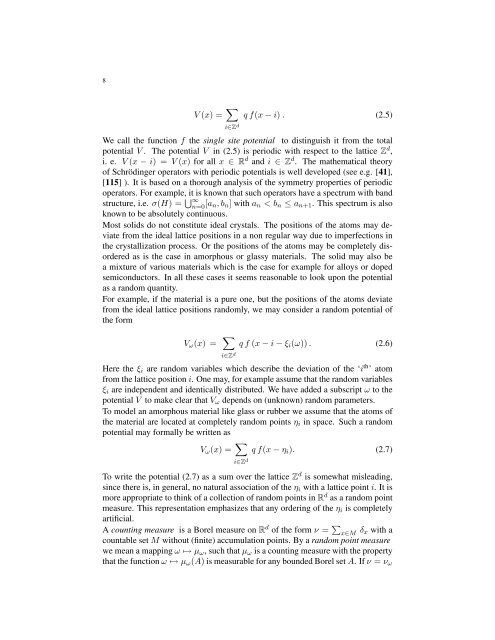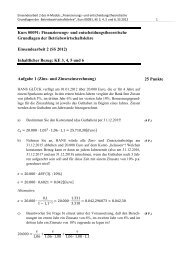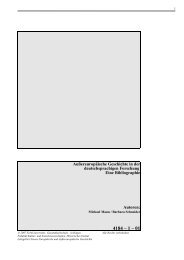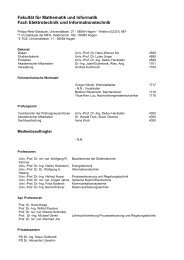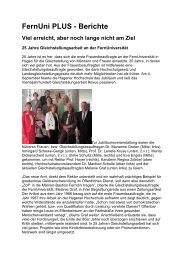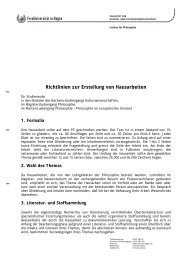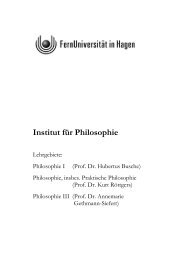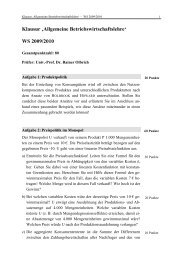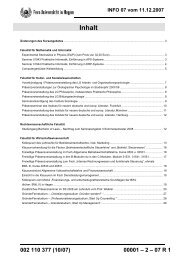An Invitation to Random Schr¨odinger operators - FernUniversität in ...
An Invitation to Random Schr¨odinger operators - FernUniversität in ...
An Invitation to Random Schr¨odinger operators - FernUniversität in ...
You also want an ePaper? Increase the reach of your titles
YUMPU automatically turns print PDFs into web optimized ePapers that Google loves.
8<br />
V (x) = ∑ i∈Z d q f(x − i) . (2.5)<br />
We call the function f the s<strong>in</strong>gle site potential <strong>to</strong> dist<strong>in</strong>guish it from the <strong>to</strong>tal<br />
potential V . The potential V <strong>in</strong> (2.5) is periodic with respect <strong>to</strong> the lattice Z d ,<br />
i. e. V (x − i) = V (x) for all x ∈ R d and i ∈ Z d . The mathematical theory<br />
of Schröd<strong>in</strong>ger opera<strong>to</strong>rs with periodic potentials is well developed (see e.g. [41],<br />
[115] ). It is based on a thorough analysis of the symmetry properties of periodic<br />
opera<strong>to</strong>rs. For example, it is known that such opera<strong>to</strong>rs have a spectrum with band<br />
structure, i.e. σ(H) = ⋃ ∞<br />
n=0 [a n, b n ] with a n < b n ≤ a n+1 . This spectrum is also<br />
known <strong>to</strong> be absolutely cont<strong>in</strong>uous.<br />
Most solids do not constitute ideal crystals. The positions of the a<strong>to</strong>ms may deviate<br />
from the ideal lattice positions <strong>in</strong> a non regular way due <strong>to</strong> imperfections <strong>in</strong><br />
the crystallization process. Or the positions of the a<strong>to</strong>ms may be completely disordered<br />
as is the case <strong>in</strong> amorphous or glassy materials. The solid may also be<br />
a mixture of various materials which is the case for example for alloys or doped<br />
semiconduc<strong>to</strong>rs. In all these cases it seems reasonable <strong>to</strong> look upon the potential<br />
as a random quantity.<br />
For example, if the material is a pure one, but the positions of the a<strong>to</strong>ms deviate<br />
from the ideal lattice positions randomly, we may consider a random potential of<br />
the form<br />
V ω (x) = ∑ i∈Z d q f (x − i − ξ i (ω)) . (2.6)<br />
Here the ξ i are random variables which describe the deviation of the ‘i th ’ a<strong>to</strong>m<br />
from the lattice position i. One may, for example assume that the random variables<br />
ξ i are <strong>in</strong>dependent and identically distributed. We have added a subscript ω <strong>to</strong> the<br />
potential V <strong>to</strong> make clear that V ω depends on (unknown) random parameters.<br />
To model an amorphous material like glass or rubber we assume that the a<strong>to</strong>ms of<br />
the material are located at completely random po<strong>in</strong>ts η i <strong>in</strong> space. Such a random<br />
potential may formally be written as<br />
V ω (x) = ∑ i∈Z d q f(x − η i ). (2.7)<br />
To write the potential (2.7) as a sum over the lattice Z d is somewhat mislead<strong>in</strong>g,<br />
s<strong>in</strong>ce there is, <strong>in</strong> general, no natural association of the η i with a lattice po<strong>in</strong>t i. It is<br />
more appropriate <strong>to</strong> th<strong>in</strong>k of a collection of random po<strong>in</strong>ts <strong>in</strong> R d as a random po<strong>in</strong>t<br />
measure. This representation emphasizes that any order<strong>in</strong>g of the η i is completely<br />
artificial.<br />
A count<strong>in</strong>g measure is a Borel measure on R d of the form ν = ∑ x∈M δ x with a<br />
countable set M without (f<strong>in</strong>ite) accumulation po<strong>in</strong>ts. By a random po<strong>in</strong>t measure<br />
we mean a mapp<strong>in</strong>g ω ↦→ µ ω , such that µ ω is a count<strong>in</strong>g measure with the property<br />
that the function ω ↦→ µ ω (A) is measurable for any bounded Borel set A. If ν = ν ω


